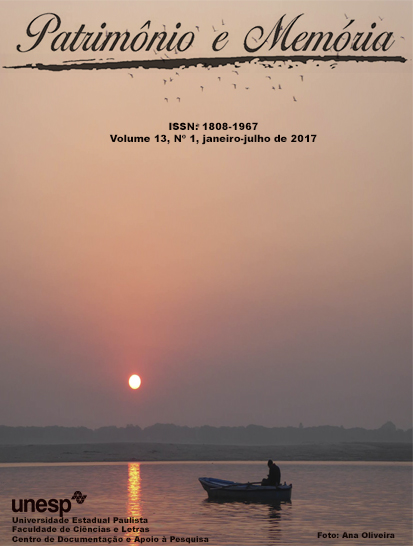Primo Levi’s ethical testimony on the grey zone
the problem of judgment and representation
DOI:
https://doi.org/10.5016/pem.v13i1.3402Keywords:
Primo Levi, Moral Judgment, Greys Zone, Auschwitz, TestimonyAbstract
This article problematizes the ethical character of Primo Levi’s literary testimony on his experience in Auschwitz. The narrative of the Italian writer offers us important insights to understand not only the Lager as a space of desubjectivation, but also outlines the role played by Nazi machine in fabricating archetypal figures with poorly defined moral shapes within concentration camps. The intention here is to examine the intricate phenomenon of “grey zone,” the paradigmatic figure of the “Muslim,” and the tragic case of Hurbinek, a child of death. The cases indicate the risk of judging these figures – who compose themselves the nebulous space of moral indeterminacy – with the measures of the present and without considering the empirical circumstances to which they were submitted. Levi argues that it is necessary to take into consideration the blind spots that define the boundaries of the grey
zones of traumatic events, from which social roles tend to be confused, mainly due to the perpetrators' strategies of imputing guilt and responsibility to the victims.
References
ADORNO, Theodor. Minima Moralia. São Paulo: Ática, 1993.
AGAMBEN, Giorgio. Homo sacer: o poder soberano e a vida nua. Belo Horizonte: Editora da UFMG, 2002.
______. O que resta de Auschwitz. São Paulo: Boitempo, 2008.
AMÉRY, Jean. Intellettuale a Auschwitz. Torino: Boringhieri, 1987.
ARENDT, Hannah. As origens do Totalitarismo. São Paulo: Companhia das Letras: 1989.
______. Eichmann em Jerusalém. São Paulo: Companhia das Letras, 1999.
______. Responsabilidade e Julgamento. São Paulo: Companhia das Letras, 2004.
BARENGHI, Mario. A memória da ofensa: recordar, narrar, compreender. Novos Estudos, São Paulo, n.73, p. 176-1912005.
BENVENISTE, Émile. O Vocábulo das Instituições Indo-Européias: Poder, Direito, Religião. Vol. 2. Campinas: Editora da UNICAMP, 1995.
BROWNING, Christopher. Des hommes ordinairesle: 101 bataillon de réserve de la police allemande et la solution finale en Pologne. Paris: Belles Lettres, 2006.
CAVARERO, Adriana. Orrorismo, ovvero della violenza sull’inerme. Milão: Feltrinelli, 2007.
DAL LAGO, Alessandro. Non-persone: l’esclusione dei migranti in una societa globale. Milão: Feltrinelli, 2004.
DELLA TORRE, Stefano Levi. Il sopravvissuto, il musulmano e il testimone: una nota critica al libro “Quel che resta di Auschwitz”, di Giorgio Agamben. Una Città, n. 83, Febbraio 2000.
DIDI-HUBERMAN, Georges. Images malgré tout. Paris: Les Éditions de Minuit, 2003.
ELIAS, Norbert. A sociedade dos indivíduos. Rio de Janeiro: Jorge Zahar, 1994.
GAGNEBIN, Jeanne-Marie. “Apresentação”. In: AGAMBEN, Giorgio. O que resta de Auschwitz. São Paulo: Boitempo, 2008a, p. 9-17.
______. Uma filosofia moral negativa? Kriterion, Belo Horizonte, vol. 49, n. 117, p. 143-152, 2008b.
JELIN, Elisabeth. Los trabajos de la memoria. Madrid: Siglo XXI de España, 2002.
LA BOÉTIE, Étienne. Le discours de la servitude volontaire. Genebra: Droz, 1987.
LAHIRE, Bernard. Patrimônios individuais de disposições: para uma sociologia à escala individual. Sociologia: problemas e práticas, n. 49, p. 11-42, 2005.
LEVI, Primo. A trégua. São Paulo: Planeta de Agostini, 2004a.
______. Conversazioni e interviste. Turim: Einaudi, 1997a.
______. É isto um homem? Rio de Janeiro: Rocco, 1988.
______. I sommersi e i salvati. Turim: Einaudi, 2007a.
______. La tregua. Turim: Einaudi, 1997b.
______. Os afogados e os sobreviventes. São Paulo: Paz e Terra, 2004b.
______. Regreso a Auschwitz: entrevista. Letras Libres, México, n. 48, p. 30-34, 2005b.
______. Se questo è un uomo. Turim: Einaudi, 2005a.
MESNARD, Philippe; KAHAN, Claudine. Giorgio Agamben à l’épreuve d’Auschwitz. Paris: Kimé, 2001.
NORRIS, Andrew (Org.). Politics, Metaphysics, and Death: Essays on Giorgio Agamben's “Homo Sacer”. Durham: Duke University Press, 2005.
OLIVEIRA, Lucas A. A fabricação de uma forma pervertida de humano: Primo Levi e os rumores da memória. Krypton: identità, potere, rappresentazioni, Roma, v. 5/6, p. 136-149, 2016.
______. Notas críticas sobre uma trajetória adversa: uma viagem de Turim a Auschwitz. Literatura e Autoritarismo, UFSM, Santa Maria, n. 22, vol. 1, p. 28-45, 2014.
______. Primo Levi e os rumores da memória: limites e desafios na construção do testemunho. 2013. 156f. Dissertação (Mestrado em Sociologia). Faculdade de Filosofia, Letras e Ciências Humanas. Universidade de São Paulo, São Paulo, 2013.
PLANINC, Zdravko. Drowning Ulysses: Saving Levi from Agamben's Remnant. Shofar, vol. 33, n. 2, p. 53-86, 2015.
POWER, Nina. Potentiality or Capacity? – Agamben’s Missing Subjects. Theory & Event, vol. 13, n. 1, 2010.
RENAULT, Emmanuel. Souffrances sociales. Paris: La Découverte, 2008.
SCHÜTZ, Anton. “The Fading Memory of Homo Non Sacer”. In: CLEMENS, Justin et al. (Orgs.). The Work of Giorgio Agamben: Law, Literature, Life. Edinburgh: University Press, 2008, p. 114-131.
SELIGMANN-SILVA, Márcio. Testemunho e a política da memória. Projeto História, n. 30, p. 71-98, 2005.
STEINBERG, Paul. Chroniques d'ailleurs: récit. Paris: Ramsay, 1996.
TODOROV, Tzvetan. Em face do extremo. Campinas: Papirus, 1995.
VERNANT, Jean-Pierre. A Morte nos olhos. Rio de Janeiro: Jorge Zahar, 1991.
WEIL, Eric. Philosophie Politique. Paris: Libraire Philosophique, 1966.
ŽIŽEK, Slavoj. Arriscar o impossível. São Paulo: Martins fontes, 2006.
ZUIN, João Carlos Soares. Sobre Primo Levi e os espaços de exceção no século XX. Estudos de Sociologia, UNESP/Araraquara, v. 14, n. 27, p. 397-421, 2009.
______. Um autorretrato de Primo Levi. As raízes literárias da narrativa de Auschwitz. Revista de Ciências Sociais, UFC, v. 44, p. 216-242, 2013.
Downloads
Published
How to Cite
Issue
Section
License
Copyright (c) 2017 Patrimônio e Memória

This work is licensed under a Creative Commons Attribution 4.0 International License.
All the content of the journal, except where noted, is licensed under a Creative Commons BY attribution license.


